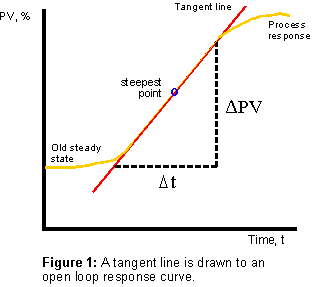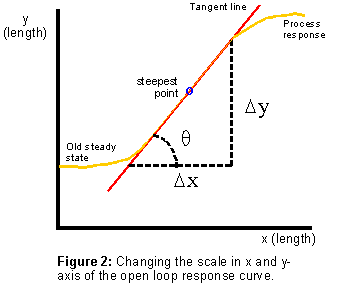
|
|
|
|
|
|
OPTIMUM
PID CALCULATION
Reformulated Tangent Method
©
Abstract
This webpage will present
an alternative method of analyzing open-loop response of a process.
In the conventional tangentmethod,
the process response rate is obtained by drawing a tangent
line at the steepest point
of the response curve and calculating
the response rate of the tangent
line. This analysis is normally
performed on a chart paper or on a hard copy of a
DCS. A new
proposed technique transforms
the process response rate calculation into a trigonometric function.
A protractorwill be used
to measure the angle made between the base line of past steady-state
level and the tangent line.
This technique simplify
and reduce the steps in analyzing the process
response rate. Frequent
analysis can be done faster and the analysis can
be performed directly on
console as compared to the
existing method.
Reformulation of Response Rate Calculation
In the tangent method, to
calculate the optimum PID, a tangent line should be drawn at the
steepest point of a processresponse
curve. The process response rate is the process
change per change in time
as shown below.

Response rate is the slope of the open loop response curve. Therefore,
![]()
The response curve as in
Figure 1 can be analyzed and viewed with different perspective
as
in Figure 2.

Then, the response rate would be,
![]()
Combining equation (i) and
(ii) together,
![]()
But equation (iii) is not
dimensionally correct. y and x have units of length; while, PV and t have
units of % and time,respectively.
Hence, a conversion factor must be added to the right hand
side of equation (iii).
![]()
where,
(% / length) is the conversion factor of the response (PV) scale
(time / length) is the conversion factor of the time (t) scale
Finally, recognizing that y / x = tan , equation (iv) transforms into
![]()
The right hand side of equation
(v) provides an alternative means of analyzing process
response rate.
(Publication
of this method in any journals, papers, magazines or conferences for personal
accreditation
must obtain
a written permission from Abdul Aziz Ishak at aabi63@hotmail.com
or
aabi63@kkps.fk.um.edu.my)
APPLICATION
EXAMPLES